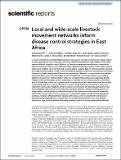| dc.description.abstract | Livestock mobility exacerbates infectious disease risks across sub-Saharan Africa, but enables critical access to grazing and water resources, and trade. Identifying locations of high livestock traffic offers opportunities for targeted control. We focus on Tanzanian agropastoral and pastoral communities that account respectively for over 75% and 15% of livestock husbandry in eastern Africa. We construct networks of livestock connectivity based on participatory mapping data on herd movements reported by village livestock keepers as well as data from trading points to understand how seasonal availability of resources, land-use and trade influence the movements of livestock. In communities that practise agropastoralism, inter- and intra-village connectivity through communal livestock resources (e.g. pasture and water) was 1.9 times higher in the dry compared to the wet season suggesting greater livestock traffic and increased contact probability. In contrast, livestock from pastoral communities were 1.6 times more connected at communal locations during the wet season when they also tended to move farther (by 3 km compared to the dry season). Trade-linked movements were twice more likely from rural to urban locations. Urban locations were central to all networks, particularly those with potentially high onward movements, for example to abattoirs, livestock holding grounds, or other markets, including beyond national boundaries. We demonstrate how livestock movement information can be used to devise strategic interventions that target critical livestock aggregation points (i.e. locations of high centrality values) and times (i.e. prior to and after the wet season in pastoral and agropastoral areas, respectively). Such targeted interventions are a cost-effective approach to limit infection without restricting livestock mobility critical to sustainable livelihoods. | en_US |

